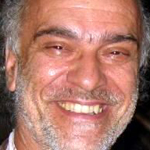Punya interviews Lakshen about his career as a film director and in particular about his movie project ‘Osho the Movie’

Lakshen, how did you get into film making?
If you are born in Rimini like me, in Federico Fellini’s birthplace, it is obvious that you want to become nothing else than a film director (just kiddin’…). I was honored that Fellini’s sister, Maddalena, was part of the cast in my first film ‘Blue Line’.
What is ‘Blue Line’ about?
It is a story of a mid-summer night in Rimini where the main character walks on the edge between reality and dream and of a spiritual search. The script for ‘Blue Line’ was based on a novel I had written earlier. Despite the fact that the film was selected for the Venice Film Festival and received a quality award from the Italian Ministry of Culture, it never found the way to a successful distribution, as it so often happens to independent films.
What was the idea behind your second film ‘Zorba the Buddha’?
With ‘Zorba the Buddha’ I wanted to show the meeting between spirit and matter, mainly to a young public. The main character of the film is a young DJ. His life is all about sex, drugs and rock & roll. He then falls in love with a mystic skipper with whom he sails around the world; a meeting of two polarities. The DJ, a contemporary, urban Zorba, was played by Siddhartha, the young kid we all know from Pune 1 – the one who, according to Osho, was going to be enlightened at 21. By the way, he now works as a DJ! To ask Sid if he finally became enlightened is like asking if the movie was good. I think that it was an honest approach for a message to the Western youth.
Now you have a third film in mind, ‘Osho the Movie’. What part of Osho’s life will be shown in it?
‘Osho the Movie’ (working title: ‘Osho, Lord of the Full Moon’) tells the story of a female journalist who follows Osho’s life in America, then onto the world tour until his death in Pune in 1990. The main character is at first very skeptical towards Osho and his commune but changes her mind through time (but will not take sannyas – otherwise it would be a propaganda movie…). In this way I hope to catch the attention of those who still see Osho with a negative attitute, which includes a large part of movie goers, especially in the States.
Apart from footage from the Ranch there will also be flash-backs of Osho’s childhood, his youth, until he becomes enlightened at 21. I intend to film this part in black and white and in a slower rhythm compared to the quicker pace which suits the periods from Rajneeshpuram until 1990. To integrate the archive material into the movie proper, the journalist pretends to film this original footage or go through some archive material. This will also save a lot of production cost and avoid building huge sets.
I have some reservations about having Osho being played by a Bollywood actor. The actors will not have the presence we have seen in Osho.
In the beginning I was also not keen in having Osho being played by an actor either from Bollywood, or elsewhere. But when I wrote the script and while working with others, some sannyasins also, we found that we had to film certain scenes for which there were no images, for example the scene where Osho eats the ‘poisoned’ breakfast in the Oklahoma prison, or some scenes from his childhood.
After many discussions I came to the understanding that there are prejudices about Osho not only from non-sannyasins but also from sannyasins, mainly from those who have known Osho personally. But if we take for example the film on Gurdjieff, ‘Meetings with Remarkable Men´, there is no problem for us to accept the actor who played Gurdjieff – because we have not known him personally. By the way, if we go and read the director’s comments by Peter Brook we come to know that Madame De Saltzman, who was very close to Gurdjieff, had helped him choose the actor!
It is clear that we have to find an actor with presence and charisma. Above all, we have to remember that this is a film and not a darshan. A film is just a ‘finger pointing to the moon’. My aim is to change the negative attitudes towards Osho which are still in the public and the media, especially concerning the period in America. If I am successful in changing their attitude, those who have seen the movie and feel touched can read his books and watch his videos if they want to know more about him.
The script is already in place, a few famous actors and a director of photography are secured, what is missing?
For the last five years I have worked on eighteen versions and am now happy with the last one. I have contacted various famous actors, mainly from India. The cast is almost done. And my director of photography, Fabio Cianchetti, is one of the best in the world. He has worked with Bernardo Bertolucci and Abel Ferrara, just to name a few.
But to find funding is more difficult. Here’s an example about the situation among Western producers: I recently met the directors of Medusa, the largest film production company in Italy, and they told me that they do not want to take the risk with a movie about such a controversial man, and in which there are allegations of a CIA conspiracy. I certainly did not expect that.
On the other hand, although India has now accepted Osho (he is no more creating the havoc he used to when alive…) Indian producers have unfortunately not yet produced one movie for the Western market. (Films like ‘Slumdog’ and those of Mira Nair or Deepa Metha have been produced with money from the West.)
At any rate, advanced negotiations with various independent producers from India and the States are under way and I believe that I will be able to start with pre-production by the beginning of next year.
You have recently started a campaign where little people like me could participate as production supporters with a ‘buy a pixel’ scheme. You called it ‘Osho the Movie powered by 10,000 Buddhas’.
The idea of the ‘Ten Thousand Buddha Club’ is to help the pre-production phase I mentioned before. I thought it would be nice not to just to ask for contributions but also to give something back. Those who contribute (a pixel costs only 40 Euro) will be seen and linked to their website or Facebook profile. As we are now counting 2000 visits a month on the site (this will go up once the film is in production) it will be quite an exposure for all of the contributors’ activities. The campaign started approximately two months ago and has had a good response so far, but still much more is needed. I am also counting on some bigger lumps to come in for which people can contact me directly.
What drives you to create this film ‘at all cost’? You say yourself that you are an ‘incurable dreamer’…
I think that every sannyasin who has been ‘touched’ by Osho wants to share his vision. Everybody has her/his own way and mine is that of a film maker. I want people, far and wide, to have the possibility to hear about his vision and I want to make justice to the rubbish which has been, and still is being said, like in the latest documentary ‘Guru’.
Osho gave me the name Lakshen which means ‘Beyond the Goal’ and I am taking this film like a sadhana, a spiritual path: constantly confronting myself with fears, doubts, expectations and frustrations. If I did not take it like this I would have probably given up long ago.
Not only do I have to go ‘beyond goals’ but also ‘beyond projections’ (and here I am speaking both in cinema and sannyas lingo). Every day I receive letters of criticism or some giving me suggestions. It reminds me a bit of watching our favorite football team and shouting instructions on how they should play!
To those who say they did not like my previous films I reply with a phrase coined by Ed Wood, the so-called ‘worst director’ in the history of cinema (they made a movie about him, played by Johnny Depp): “My next film will be better.” He too was an incurable dreamer…
Lakshen spoke with Punya
Read an update on this project… and more media coverage
 Lakshen took sannyas in 1978 after being involved in left-wing and anarchic politics (most Italian sannyasins at the time came from those groups…). He was part of the communes in Pune and in Oregon, and ran the only ‘Zorba the Buddha’ sannyas disco in Italy. He is an author, script writer, and film director. www.oshothemovie.com
Lakshen took sannyas in 1978 after being involved in left-wing and anarchic politics (most Italian sannyasins at the time came from those groups…). He was part of the communes in Pune and in Oregon, and ran the only ‘Zorba the Buddha’ sannyas disco in Italy. He is an author, script writer, and film director. www.oshothemovie.com




Comments are closed.